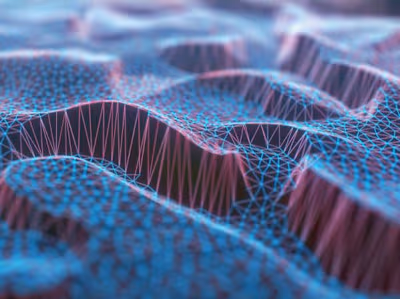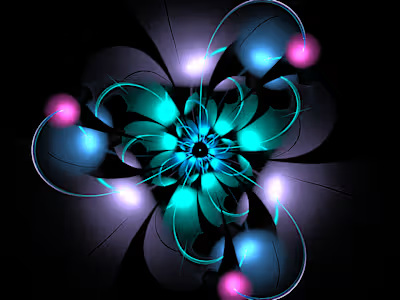Neutrons ‘Are Not’ Fundamental Particles by Keith D. Foote
Characteristics and Myths The USF theory1 distinguishes between a single, short-lived independent neutron and pseudo-neutrons existing as part of an atomic core. A true neutron is a proton
with an electron located in the innermost Van Allen belt,* and which has recently separated from an atomic core. Within the core of an atom, core electrons are shared, partially neutralizing all surrounding protons and turning them into pseudo-neutrons.
An isolated neutron is not a stable entity. Within ten to twenty minutes of its separation from an atom, a neutron will typically break down in a process called
‘beta decay.’ It separates into a proton and an ejected electron. (Beta decay is also a form of electron-based radioactivity found in elements such as radium.)
The electron of an isolated, independent neutron encompasses the proton at its equator. The neutron generates a gravity field, a thermal field, and a magnetic field, and is considered electrically neutral. It is very sensitive to other magnetic fields and readily adjusts its polar orientation to the surrounding environment. (This supports the theory orbiting electrons influence a proton’s/molecule’s magnetic orientation.)
*(This is not a new concept. Several scientists have created a neutron model with an electron in a tight orbit. On October 20, 2001, at a High Temp. Nuclear Synthesis II Mini-symposium, Michael Famiano and Richard Boyd, of Ohio State University, and Toshitaka Kajino, of the University of Tokyo, proposed a similar neutron model.)
This thesis proposes neutrons have been accidentally labeled as fundamental particles and provides arguments supporting the position neutrons are protons with an electron in an inner orbit and are neither permanent, nor fundamental.
encircling electron
The magnetic sensitivity of the neutron has made it an excellent tool for studying the magnetic domains in solids.
Prior to separation from an atom’s core, the neutron’s inner orbit electron is shared by two (or more) core protons, making both pseudo-neutrons. This provides for additional bonding, and counters proton-proton repulsion at close range. When two pseudo-neutrons are forced to separate, one often takes the core electron and leaves as a full neutron.
Neutrons, as part of an atomic nucleus, are pseudo-neutrons, which remain stable and are essential to the formation of the elements. The pseudo-neutron’s electric, magnetic, and gravity fields can link with those of other pseudo-neutrons to create a complex atom. Currently, it is generally believed neutrons form an external layer, or shell, around complex atoms. The USF theory disagrees with this model and suggests all protons and neutrons within an atom’s core are pseudo-neutrons.
In a process called electron capture, it is believed heavier atoms can absorb an electron into their core, changing a proton into a neutron, or, in this model, adding an electron to the electrical balance of pseudo-neutrons, and changing the atom from one element to another. The process is inferred by emitted x-rays, theoretically produced as outer electrons shift inward to replace the absorbed inner orbit electron.
Electron capture, combined with the short life of a neutron after leaving its atomic core, provide hard supporting evidence for the conclusion neutrons are not fundamental particles.
The weight of a neutron is just slightly more than that of a proton. This model predicts the additional weight is not caused by a gravity field from the electron, but from the coulombic warpage of space as an electron and proton are attracted to one another at such close range. Within the atom’s core this additional warpage of space increases the atom’s overall gravity field.
Precise measurements show the neutron’s inertia slightly exceeds the combined inertia of a proton and an electron by 0.01 percent (this 0.01 percent is 260 times more inertia than of a single, lone electron). Inertia should not be confused with weight, as the electron is spread out like a sail while moving with the proton, and promotes increased resistance as it moves through an EM or thermal field.
Because the neutron is electrically neutral when approaching an atom, it doesn’t meet with the same repulsion a proton would encounter. It does continue to meet with long-range magnetic repulsion, short-range magnetic and gravitational attraction, and thermal field resistance, but the lack of proton/proton repulsion normally shifts the balance of repulsive and attractive forces, allowing the neutron easier access to an atom’s core in many materials. This in turn allows for fission, or nuclear energy.
This model predicts the electron orbiting a cold neutron is more tightly bound than the electron of a warmer neutron.
The temperature, or thermal field, of a neutron effects its interactions with matter and atoms. This is shown in experiments using ‘cold’ neutrons. Neutrons are able to pass through certain materials, such as graphite and beryllium, having atomic cores surrounded by densely organized electric fields. When slow moving neutrons are introduced into these substances, they act as a filter, allowing only cold neutrons (neutrons with reduced thermal fields) to pass through, while warmer ones are deflected back after interacting with an atom.
Cold neutrons, unlike warm neutrons, can reflect off a polished surface, and can become polarized (their north/ south poles uniformly aligned) by the reflection process. A sheet of magnetized material can also polarize neutrons, by allowing those neutrons magnetically aligned with the sheet to pass through, and reflecting those which are not.
Additionally, a beam of cold neutrons passing through a magnetized iron block will become polarized, though in this case the emerging neutrons are magnetically aligned in the opposite direction of the iron block, while those with the same alignment are deflected away in different directions. This inverse alignment process is predicted to be both magnetic and electric in nature. As the neutron passes the polarized atoms in the iron magnet, the orbiting electric fields interact. As the gears in a clock move in opposite directions, so the neutron’s electron shifts to an opposite orientation. The electron is an east monopole, and its preferred orientation is east. The neutron’s magnetic field adjusts as well, with its unanchored north/south poles being attracted to their more stabilized opposites to become ‘inversely polarized.’
The current ‘Standard Model’ of the neutron describes it as a proton with its surface
completely surrounded by a meson. The meson carries a charge equivalent to one electron volt. Quark theorists believe the meson is a quark/antiquark pair, though there is no direct evidence supporting this concept and the circumstantial evidence is very weak.
The Fallacy of Proton Decay While there are numerous observations of neutrons ejecting an electron and becoming a proton, proton decay has never been observed. The Standard Model of a proton transforming into a neutron by ejecting a positron and an antineutrino has never been confirmed and has no direct supporting evidence. Circumstantial evidence is ‘extremely’ weak.
Historical Info James Chadwick discovered the neutron in 1932. Since then, it has caused consid- erable confusion. Initially, the neutron was considered a fundamental particle, and apparently continues to be, by physicists who learned of physics through rote memorization. The neutron is not capable of an indefinite, independent existence. Early experiments failed to observe the neutron’s separation into a proton and an electron after the passage of ten to twenty minutes.
One of the earliest neutron theories was symmetry-based and described the neutron as the result of a proton and antiproton passing one another, exchanging charges, and producing two neutrons (a collision would annihilate the proton and antiproton). Though this theory was never confirmed, and current observations do not support it, it continues to be used (perhaps unknowingly) as the unspoken foundation for neutron theory.
Within a few years of its development, this early model was modified to explain the emission of positrons from elements such as aluminum and potassium. After being bombarded by alpha particles (described by the standard model as helium ions- two protons, two neutrons, no electrons), these elements emitted positrons and electrons. In developing a symmetry-based model for the neutron, it was theorized a proton would become unstable and eject a positron (proton decay), transforming it into a neutron. This model was further supported by positron emissions from unbalanced radioactive elements which simultaneously transformed protons into neutrons. (The USF theory does not support this model and explains these processes as pair creation/pair production and electron capture.)
After the discovery of the neutron, beta (electron) radiation was confirmed to be the result of a neutron breaking down into a proton and electron (the radioactive element gradually changed from one element to another as the number of electrons in each atom changed). This observation was used, erroneously, to expand the model, and used a symmetry philosophy to declare, “Neutrons can become protons by emitting an electron, and protons can become neutrons by emitting positrons.” (A proton has never been observed emitting a positron to become a neutron.)
The varying directions and speeds of the electrons during neutron decay became a significant problem for mathematical theorists because it conflicted with the ‘law of conservation of energy.’ The concept of neutrinos (massless, chargeless particles) was developed as an explanation. Early on, neutrinos were a questionable mathe- matical requirement with no evidence supporting their physical existence.
The USF theory explains the varying speeds of electrons ejected from neutrons as the result of environmental magnetic, electric, and thermal variations, combined with varying polar orientations within the atom itself.
Though completely unobserved, and with no supporting evidence, the symmetry-based model of proton decay (the theory a proton becomes a neutron by ejecting a positron) was extended to include an ‘antineutrino’ as part of the decay process.
In the mid to late 1930s, this modified model was also used to explain the heating of Sol. In a process called the proton-proton reaction, fusion was described as two protons colliding and remaining attached, and then converting to deuterium, a heavy form of hydrogen with a proton and a neutron. According to this early model, one of the protons in the pair becomes a neutron by ejecting a positron and an antineu- trino. (The USF theory includes a core electron in the fusion of deuterium, and does not support the ejection of a positron and an antineutrino.)
In 1935, Hideki Yukawa proposed the protons in the cores of atoms were held together by a force overpowering proton/proton repulsion. Yukawa calculated the force was continuously absorbed and emitted from the proton in 1/100,000,000 of a second. The force came to be called a meson. He also predicted the meson had 200-300 times more mass than the electron. A single electron was considered too small to explain the stronger inertia of the neutron. Yet, when the neutron separates
into a proton and an electron, the excess inertia disappears (and, per the Standard Model, becomes a neutrino). It should be pointed out, the Ultra-Space Field Theory does not fully support the currently popular model of fusion within stars, but that’s another paper.
Neutrinos Described as massless and chargeless, the neutrino’s impact on matter is considered to be essentially nonexistent. While being extremely difficult to detect, it does provide a solution for the dilemma faced by particle theorists because of the law of conservation of energy. Gradually the concept of a neutrino became accepted out of mathematical necessity, but observational proof of its existence remained a challenge.
In 1956, Clyde Cowan and Frederick Reines set up an experiment at the Los Alamos Scientific Laboratories designed to detect gamma rays. A tank of water was placed in front of a plutonium breeder reactor and observed. Gamma rays were detected, and this was interpreted to mean positrons and electrons had combined to create them.
Following the (never observed) proton decay model, this meant protons in the water had transformed into neutrons by releasing positrons and antineutrinos. It was further theorized the protons made this transformation after receiving neutrinos from the reactor, which in turn had been created by earlier neutron decay. Based on these observations the antineutrino, and the neutrino, came to be accepted as physical realities by people who wanted to believe. Similar to the Higgs Boson as an illusion.2
Neither the creation of gamma rays, nor the presence of positrons in matter, prove the existence of an antineutrino, nor its symmetrical counterpart, a neutrino. To date, this rationale is still used as evidence of neutrinos, though the wording has become so overly-simplified it is now a fictional description. There has never been direct evidence supporting the concept of neutrinos, and all circumstantial evidence can be explained using other interpretations.
Over time, other types of neutrino detectors have been designed and built, primarily with the intention of researching neutrinos from Sol and from supernovas. Many are water-based detectors that infer the existence of neutrinos by gamma rays or electron-sourced Cerenkov radiation. The SAGE neutrino detector infers neutrino
emissions by the number of atoms converting from gallium to germanium each month. (A gallium atom converts to germanium by transforming a neutron into a proton and electron.) At present, neutrino research has produced minimal and unpre- dictable results and absolutely no new technologies. The announcement of neutrinos traveling faster than the speed of light was based on a ‘proven-to-be-flawed- without-a-doubt’ experiment (electrical issues in the equipment). There is no doubt neutrino detectors are measuring something, but hard supporting evidence of ‘actual’ neutrinos does not exist, and their measurements may be based on any number of various, underlying phenomenon, and not the existence of neutrinos.
Neutron Inertia The inertia of a neutron has been measured and found to be slightly higher than the inertia of a proton. The standard model eliminates the electron as the source of inertia because a individual electron is not considered gravitationally strong enough. A different model of how an electron orbits a neutron provides a different conclusion.
In the USF theory paradigm, the electron is contained in the innermost Van Allen belt and encircles the neutron at its equator. The single electron field is spread out significantly and, as with a feather, it meets with greater resistance than it would in its more concentrated, free electron form.
According to the USF theory model, core electrons within an atom are shared by pseudo-neutrons and are trapped by the shared attraction of other protons. Within the atom’s core, the attraction of electron to proton produces a contraction of space and a minute amount of additional gravity. When a pseudo-neutron is separated from an atom, with only the innermost VA belt holding the electron in position, the free neutron cannot contain the electron for an extended period of time. During decay, magnetic and thermal repulsion forces the ejection of the electron.
Neutron Acceleration For several decades, consensus opinion has ruled out the possibility of accelerating neutrons to high velocities because of its electrical neutrality. In 1993, J. Anandan, of the Univ. of South Carolina, and C.R. Hagen, of the Univ. of Rochester devised a gedankin experiment (a thought experiment) describing the process of acceler- ating a neutron using magnetic and electric fields. The USF theory predicts a moving electric field could be used to repel/accelerate a neutron via its magnetic field. (Stabilizing the neutron’s encircling electron is a separate problem.)
References
[1] ‘Ultra-Space Field Theory’, K. Foote, Cosmos Books, Ann Arbor, 2005. (Available at Google Books.)
[2] ‘The Higgs Boson: Reality or Mass Illusion, K. Foote, @http://vixra.org/abs/1210.0044
Like this project
Posted Jun 8, 2024
This model proposes neutrons have been accidentally labeled as fundamental particles and argues neutrons are protons with an encircling electron.
Likes
0
Views
4





